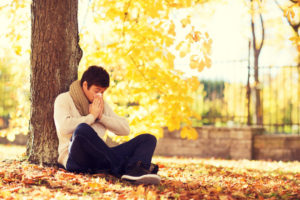What Could be Causing Your Itchy, Watery Eyes?
- Posted on: Sep 30 2021
 Itching, watering, redness, and other irritating eye symptoms may be caused by a few different factors. It is important to pay attention to ocular symptoms so that we may begin to uncover their origin. Usually, a little eye irritation is no big deal and will pass with time and rest. It could be that we’ve stared at a computer screen for too many hours or that there is something in the air that is affecting our body. When symptoms recur or persist, it is beneficial to see an ophthalmologist. Doing so can help you differentiate between potential reasons for your eye irritation. Here, we discuss what sets fall eye allergies apart from dry eye disease and what you might do if you think you have either of these conditions.
Itching, watering, redness, and other irritating eye symptoms may be caused by a few different factors. It is important to pay attention to ocular symptoms so that we may begin to uncover their origin. Usually, a little eye irritation is no big deal and will pass with time and rest. It could be that we’ve stared at a computer screen for too many hours or that there is something in the air that is affecting our body. When symptoms recur or persist, it is beneficial to see an ophthalmologist. Doing so can help you differentiate between potential reasons for your eye irritation. Here, we discuss what sets fall eye allergies apart from dry eye disease and what you might do if you think you have either of these conditions.
Allergies occur when we are exposed to a trigger. This trigger, be it food, a chemical, or an environmental allergen, stimulates an immune response in which the body produces histamines. It is the histamines that cause redness, watering, itching, and potentially even swelling of the eyelids. Dry eye disease occurs when the glands in the eyes do not produce a sufficient tear film to maintain adequate moisture across the ocular surface. The lack of moisture results in similar symptoms to ocular allergies. We can discern between the two conditions by looking at severity and the list of irritations that occur. When a person has eye allergies, itching may be intense. When a person has dry eye disease, they may experience severe grittiness, stinging, and watering that interfere with daily activities.
Ocular allergies and dry eye disease may both require treatment. When symptoms of either persist or recur, a comprehensive eye exam can determine their cause. The benefit of knowing the cause is, of course, then knowing how to manage symptoms.
Managing Fall Eye Allergies
Ocular allergies may differ from season to season. Usually, we think of Spring as allergy season. However, certain triggers may also thrive in the Fall. These include:
- Dust mites
- Pollen
- Mold
- Ragweed
- Goldenrod
- Pigweed
- Spores
- Sagebrush
- Sorrel
Managing Fall Eye Allergies
First, if you think you may have ocular allergies, we invite you to contact one of our conveniently located offices for a thorough eye exam. Once you know that you have ocular allergies, you can implement strategies to help you avoid and manage triggers. Suggestions include:
- Learn your triggers so you’re not trying to avoid every potential allergen.
- Follow pollen counts if this is one of your triggers. On days when pollen count is high, stay indoors as much as possible or take allergy medication as prescribed by a doctor.
- If you are allergic to pollen, try to remain indoors in the early morning hours when most plants are releasing pollen. It is usually better to go outdoors in the afternoon.
- If mold is prevalent in your area, place a dehumidifier in your home.
- To prevent mold growth around the home, remove dead leaves regularly.
- If you develop an allergy flare-up and wear prescription contact lenses, switch to eyeglasses until inflammation has subsided.
Roholt Vision Institute has offices in Canfield, Alliance, and North Canton. We are happy to help you uncover the cause of persistent ocular symptoms. Contact us today to schedule a visit.
Posted in: Dry Eyes
